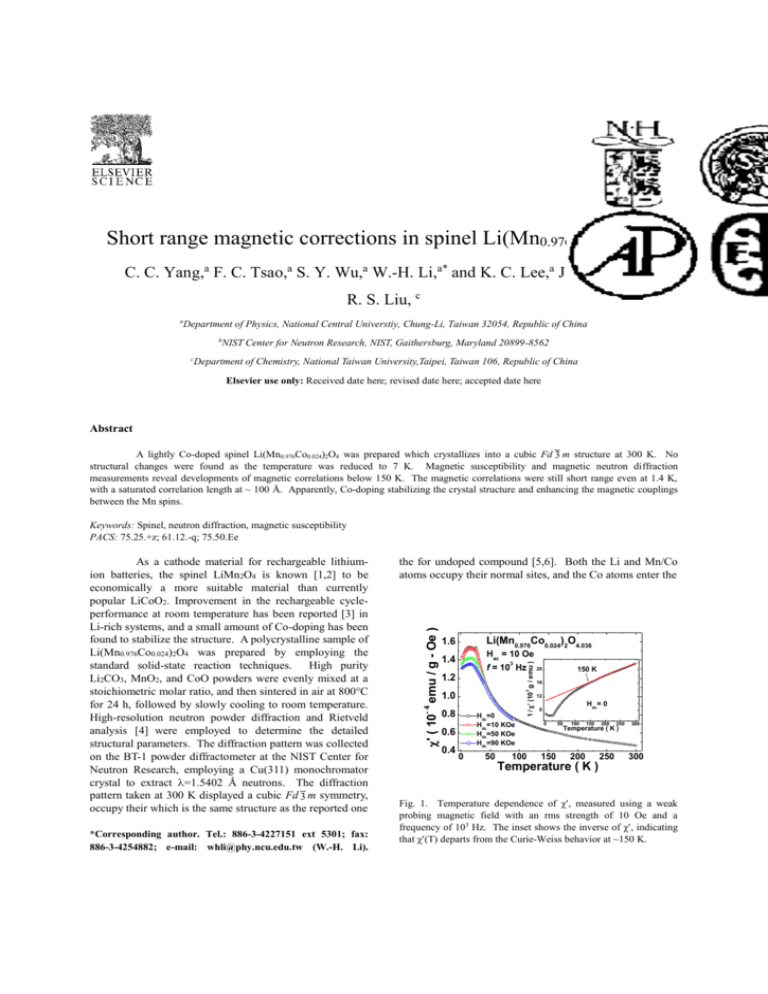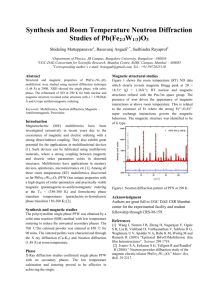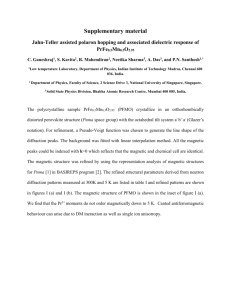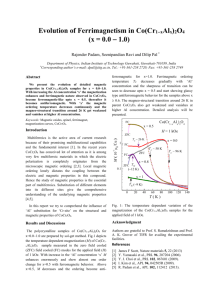Article
advertisement

Short range magnetic corrections in spinel Li(Mn0.976Co0.024)2O4
C. C. Yang,a F. C. Tsao,a S. Y. Wu,a W.-H. Li,a* and K. C. Lee,a J. W. Lynn,b
R. S. Liu, c
a
Department of Physics, National Central Universtiy, Chung-Li, Taiwan 32054, Republic of China
b
NIST Center for Neutron Research, NIST, Gaithersburg, Maryland 20899-8562
c
Department of Chemistry, National Taiwan University,Taipei, Taiwan 106, Republic of China
Elsevier use only: Received date here; revised date here; accepted date here
Abstract
A lightly Co-doped spinel Li(Mn0.976Co0.024)2O4 was prepared which crystallizes into a cubic Fd 3 m structure at 300 K. No
structural changes were found as the temperature was reduced to 7 K. Magnetic susceptibility and magnetic neutron diffraction
measurements reveal developments of magnetic correlations below 150 K. The magnetic correlations were still short range even at 1.4 K,
with a saturated correlation length at ~ 100 Å. Apparently, Co-doping stabilizing the crystal structure and enhancing the magnetic couplings
between the Mn spins.
Keywords: Spinel, neutron diffraction, magnetic susceptibility
PACS: 75.25.+z; 61.12.-q; 75.50.Ee
*Corresponding author. Tel.: 886-3-4227151 ext 5301; fax:
886-3-4254882; e-mail: whli@phy.ncu.edu.tw (W.-H. Li).
the for undoped compound [5,6]. Both the Li and Mn/Co
atoms occupy their normal sites, and the Co atoms enter the
1.6
Li(Mn0.976Co0.024)2O4.036
1.4
Hac = 10 Oe
3
f = 10 Hz 20
1.0
0.8
Hdc=0
Hdc=10 KOe
Hdc=50 KOe
Hdc=90 KOe
0.6
0.4
150 K
16
3
1.2
1 / ' (10 g / emu )
-4
' ( 10 emu / g - Oe )
As a cathode material for rechargeable lithiumion batteries, the spinel LiMn2O4 is known [1,2] to be
economically a more suitable material than currently
popular LiCoO2. Improvement in the rechargeable cycleperformance at room temperature has been reported [3] in
Li-rich systems, and a small amount of Co-doping has been
found to stabilize the structure. A polycrystalline sample of
Li(Mn0.976Co0.024)2O4 was prepared by employing the
standard solid-state reaction techniques. High purity
Li2CO3, MnO2, and CoO powders were evenly mixed at a
stoichiometric molar ratio, and then sintered in air at 800°C
for 24 h, followed by slowly cooling to room temperature.
High-resolution neutron powder diffraction and Rietveld
analysis [4] were employed to determine the detailed
structural parameters. The diffraction pattern was collected
on the BT-1 powder diffractometer at the NIST Center for
Neutron Research, employing a Cu(311) monochromator
crystal to extract =1.5402 Å neutrons. The diffraction
pattern taken at 300 K displayed a cubic Fd 3 m symmetry,
occupy their which is the same structure as the reported one
0
50
100
12
Hdc= 0
8
0
150
50
100
150
200
250
Temperature ( K )
200
250
300
300
Temperature ( K )
Fig. 1. Temperature dependence of χ, measured using a weak
probing magnetic field with an rms strength of 10 Oe and a
frequency of 103 Hz. The inset shows the inverse of χ, indicating
that χ(T) departs from the Curie-Weiss behavior at ~150 K.
(0 1 1) Li(Mn
Li(Mn Co 0.976Co
) O0.024)2O4.036
200
0.976
7600
7400
100
0.024 2
4.036
(1 1 1)
(0 1 ½)
7200
0
7000
150 K
2
Submitted to Elsevier Science
6600
= 2.359 Å
2 = 31°
6400
-200
200
-100
0
20
15
20
I1.4 K - I160 K
(0 1 1) Li(Mn
Co0.024)2O4.036
0.976
40
60 80 100 120 140 160
100 30
25
35(0 1(40
½)
Temperature
K ) 45 50
Scattering angle 2 ( deg. )
(1 1 1)
55
0
-100
I1.4 K - I160 K
-200
15
20
25
30
35
40
45
Scattering angle 2 ( deg. )
50
Peak intensity / 10 min
6800
Net counts / min.
Peak
/ 10 min
Net intensity
counts / min.
7800
7800
7400
7200
7000
6800
Mn sites. Analysis of the occupancy factors gave a
chemical formula of Li(Mn0.976Co0.024)2O4.036 for the
present compound. No traces of any impurity phases were
found, as the temperature was reduced to 7 K, showing that
2.4% Co-doping stabilizing the crystalline structure against
temperature change.
The effects of Co-doping on the magnetic
properties of the system were studied by means of ac
magnetic susceptibility and neutron magnetic diffraction
measurements. Neutron magnetic diffraction measurements
were also conducted at the NIST Center for Neutron
Research, using the BT-9 triple-axis spectrometers, with a
pyrolytic graphite PG(002) monochromator crystal and PG
filters to extract =2.359 Å neutrons.
Figure 1 shows the in-phase component of the ac
magnetic susceptibility, χ(T), measured at various applied
dc magnetic fields. The main features perceivable in χ(T)
are the peaks at ~15 K. Finite values for χ were obtained
at low temperatures, cusps in the χ(T) curves are clearly
seen, and an applied field suppresses the responses in χ at
low temperatures, suggesting the existence of both the
ferromagnetic and antiferromagnetic components for the
Mn moments. Although the peaks occur at ~15 K, the
correlations between the Mn spins develop at a much
higher temperature, as indicated by the observations that
χ(T) departs from the Curie-Weiss behavior at ~150 K, as
can be seen in the 1/χ curve shown in the inset to Fig. 1.
Figure 2 shows the magnetic diffraction pattern
obtained at 1.4 K, where the pattern taken at 160 K, which
serves as the nonmagnetic background, has been subtracted
from the data to isolate the magnetic signal. Two broad
peaks at around 2θ=31 and 45, with very different widths,
are clearly revealed, signaling the development of shortrange magnetic correlations among the Mn spins, as the
temperature was reduced from 160 to 1.4 K. Detail
investigations show that the magnetic intensities can be
described by using three peaks, as marked by the dashed
curves shown in Fig. 2. These peaks may be indexed using
the nuclear unit cell, as were marked in Fig. 2. This
= 2.359 Å
2 = 31°
6600
6400
0
55
Fig. 2. Magnetic diffraction pattern observed at 1.4 K, showing
that the magnetic correlations among the Mn spins are still short
range even at 1.4 K.
Li(Mn0.976Co0.024)2O4.036
7600
20
40
60
80
100 120 140 160
Temperature ( K )
Fig. 3. Temperature dependence of the intensity at 2θ=31, below
150 K. The solid curve is only a guide to the eye.
magnetic diffraction pattern observed for the 2.4% Codoped compound is similar to that was observed [6] in the
undoped compound, but with the widths of the peaks are
much broader. As has been observed [6,7] in the undoped
compound, there are both the both the ferromagnetic,
characterized by the {111} peak, and antiferromagnetic,
characterized by the {01½} and {011} peaks, components
for the Mn moments in the present 2.4% Co-doped
compound. The magnetic correlation lengths that we
obtained for the 2.4% Co-doped compound at 1.4 K are 100
Å and 30 Å for the antiferromagnetic and ferromagnetic
components, respectively, which are somewhat smaller
than the 120 Å and 40 Å observed for the undoped
compound [6].
The temperature dependence of the intensity at
2θ=31 is shown in Fig. 3, where the solid curve is only a
guide for the eye. Apparently, the magnetic correlations
began to develop below Tm=150 K, which agrees with the
temperature at which χ(T) departs from the Curie-Weiss
behavior. This Tm observed for the 2.4% Co-doped
compound is almost a factor of 2 higher than that of the
undoped compound, showing that the Co-doping enhancing
the couplings between the Mn spins.
The work at was supported by the NSC of the
ROC under Grant No. NSC 91-2112-M-008-056.
References
1. M. Thackeray et al., Mater. Res. Bull. 18, 461 (1983).
2. D. Guyomard et al., Solid State Ionics 69, 222 (1994).
3. R. J. Gummow et al., Solid State Ionic 69, 59 (1994).
4. H. M. Rietveld, J. Appl. Cryst. 2, 65 (1969).
5. W. I. F. David et al., J. Solid State Chem. 67, 316 (1987).
6. C. C. Yang et al., Mat. Sci. Eng. B 95, 162 (2002).
7. I Tomeno et al., Phys. Rev. B 64, 94422 (2001).









